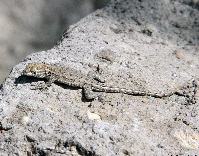Northern Side-Blotched Lizard (Uta stansburiana stansburiana)
Description: Side-blotched Lizards are petite lizards that are covered with fine granular scales with the exception of the tail, which has scales that are slightly keeled. Two other morphological characteristics of this species are the gular fold on the throat and the large interparietal scale on the top of the head. The third eye (the parietal eye) is easily located in the center of this scale. The dorsal ground color of Side-blotched Lizards is generally a light shade of gray or tan that is sprinkled with both light and dark colored spots. Some of these spots may be light blue on both sexes, and males often have orange sides and neck, particularly during the breeding season. The ventral coloration of Side-blotched Lizards is more subdued, being a light cream or white. The most obvious marking is the namesake of these lizards, and is the dark bluish-black spot that is present on the sides behind the forelimbs. These spots are more distinct in males, but females and juveniles generally have the marking to some degree. Overall, females and juveniles are less vividly colored than their male counterparts.
Habitat: Habitats include a wide variety of arid and semiarid situations with scattered bushes and/or scrubby trees; soil may be sandy, gravelly, or rocky; the species is often found in sandy washes with scattered rocks and bushes. Eggs are buried in sandy soil.
Range: The geographic range extends from central and eastern Oregon, central Washington, southwestern Idaho, Utah, and western Colorado. Elevational range extends from below sea level in desert sinks to about 9,000 feet.
Diet: Side-blotched lizards are an opportunistic forager that waits for prey to wander within close proximity. It feeds on a variety of insects including grasshoppers, beetles, ants, and termites. It also eats a variety of spiders, scorpions, and occasionally some plant material.
Reproduction: Multiple clutches of eggs are laid in spring and summer. Clutch size ranges from 2 to 5 eggs. Hatchlings begin to emerge in June.
Status: Listed as Least Concern in view of the large and stable extent of occurrence, area of occupancy, number of subpopulations, and population size. No major threats are known.
»» Kingdom: Animalia - Animals
»» Phylum: Chordata - Chordates
»» Subphylum: Vertebrata - Vertebrates
»» Class: Reptilia - Reptiles
»» Order: Squamata - Lizards
»» Family: Phrynosomatidae - North American Spiny Lizards
»» Genus: Uta
»» Species: Uta stansburiana - Common Side-Blotched Lizard
»» Subspecies: Uta stansburiana stansburiana - Northern Side-Blotched Lizard
This article uses material from the Wikipedia article "Common Side-Blotched Lizard", which is released under the Creative Commons Attribution-Share-Alike License 3.0. Content may have been omitted from the original, but no content has been changed or extended.
|






